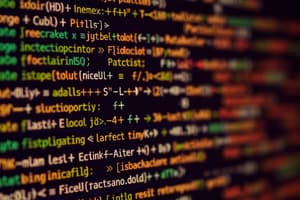Podcast
Questions and Answers
What is the primary difference between a void function and a value-returning function in C++?
What is the primary difference between a void function and a value-returning function in C++?
- Void functions can accept arguments by reference, while value-returning functions only accept arguments by value.
- Void functions do not return any value, while value-returning functions return a specific value. (correct)
- Void functions are faster in execution, whereas value-returning functions are slower.
- Void functions can only be called once, while value-returning functions can be called multiple times.
Which type of function would be most suited to calculate the square root of a number, and why?
Which type of function would be most suited to calculate the square root of a number, and why?
- A function that passes by reference to modify the base number's memory location.
- A void function because it modifies the number directly.
- A value-returning function as it returns the computed square root. (correct)
- A function that utilizes default arguments, as this allows for easy recalculation
What is the main purpose of using default arguments in a C++ function?
What is the main purpose of using default arguments in a C++ function?
- To make the function execute faster by predefining some values.
- To prevent the function from modifying the values passed in.
- To provide flexibility to call the same function with a varying number of arguments. (correct)
- To allow a function to return multiple values.
When a variable is passed by reference to a function, how does it affect the original variable in the calling function?
When a variable is passed by reference to a function, how does it affect the original variable in the calling function?
In C++, what is the role of the return statement inside a function?
In C++, what is the role of the return statement inside a function?
Can a C++ function have multiple return statements and if so, how does this affect its execution?
Can a C++ function have multiple return statements and if so, how does this affect its execution?
Why is it beneficial to divide a program into multiple functions when calculating student grades?
Why is it beneficial to divide a program into multiple functions when calculating student grades?
Which of the following scenarios best describes when to use a recursive function?
Which of the following scenarios best describes when to use a recursive function?
Flashcards
What is a void function?
What is a void function?
A function that does not return a value. It might perform actions based on input parameters. Example: A function that prints a welcome message to the console.
What is a value-returning function?
What is a value-returning function?
A function that calculates and sends back a value. Useful for computations and retrieving data. Example: A function that calculates the area of a rectangle and returns the result.
What are default arguments in functions?
What are default arguments in functions?
They provide default values for function parameters. If no value is given, the default one is used. Defined by specifying the value after the parameter declaration with an equal sign. Example: greetUser(name = "John"), where "John" is the default.
Compare pass-by-value and pass-by-reference.
Compare pass-by-value and pass-by-reference.
Signup and view all the flashcards
What is the significance of the return statement in a function?
What is the significance of the return statement in a function?
Signup and view all the flashcards
How does dividing a program into functions improve readability and maintainability?
How does dividing a program into functions improve readability and maintainability?
Signup and view all the flashcards
Write a function isEven(int number) that returns true if number is even, false otherwise.
Write a function isEven(int number) that returns true if number is even, false otherwise.
Signup and view all the flashcards
Write a function calculateAreaPerimeter(int &l, int &b) that calculates area and perimeter of a rectangle by reference.
Write a function calculateAreaPerimeter(int &l, int &b) that calculates area and perimeter of a rectangle by reference.
Signup and view all the flashcards
Study Notes
Functions in C++: Practice and Assessment
- C++ functions are blocks of reusable code.
- Functions can be void (don't return a value) or value-returning (return a specific data type).
- Void functions perform tasks without providing a result, while value-returning functions calculate and output a value.
- Example: A void function might display a message to the screen,
- while a value-returning function might calculate and return the sum of two numbers.
- Default arguments provide a preset value for function parameters. If no argument is supplied during a function call, the default value is used.
- Example:
greetUser(string name, string greeting = "Hello").
- Example:
- Pass-by-value creates a copy of the argument, while pass-by-reference uses the original variable directly.
- Pass-by-value may preserve the original variable's value,
- pass-by-reference can alter it in the function.
- A return statement exits a function and sends a value back to the caller.
- Functions can have multiple return statements to handle different cases more efficiently in different execution paths.
- Dividing a program into multiple functions improves readability and maintainability. Functions isolate specific tasks, making them easier to understand, test, and modify. For example, calculating the grades of students, input, calculation, output.
Programming Practice Questions 1 and 2
isEvenfunction: Takes an integer and returnstrueif even andfalseotherwise.calculateAreaPerimeterfunction: Takes length and breadth (by reference) of a rectangle to calculate and return the area and perimeter.
Programming Practice Questions 3 and 4
greetUserfunction: Takes a user's name as input and outputs a greeting message with the name. Allows a default greeting like "Hello".sumOfDigitsfunction: Takes an integer and recursively calculates the sum of its digits.
Programming Practice Question 5
- Program with separate functions: The program takes 2 numbers, finds their Greatest Common Divisor (GCD), and outputs the result.
Syntax Error Questions 1
- Missing semicolon: The
coutstatement was missing a semicolon (;).
Syntax Error Questions 2
- Missing curly braces:
int calculateSum(int a, int b)was missing curly braces{}around the return statement. This should have beenint calculateSum(int a, int b) { return a + b; }.
Syntax Error Questions 3
- Missing parameter in the function call: The call to
multiply(5)is incomplete. It should have two parameters,multiply(5,someValue)to work correctly. Parameteryis missing.
Syntax Error Questions 4
- Function declaration must match definition and parameters: The
void displayMessage();declaration in themainfunction must match the argument list in the function definition. The functiondisplayMessagewas missing from the main function.displayMessage();was also needed inmain().displayMessage()should be defined as a function with no parameters if there are no parameters that will be needed in that function. The added statement should complete a function call in themainfunction.
Syntax Error Questions 5
- Missing return type, missing curly braces: The function
calculateAveragewas missing thefloatreturn type, and curly braces ({}) around the return statement.
Studying That Suits You
Use AI to generate personalized quizzes and flashcards to suit your learning preferences.




